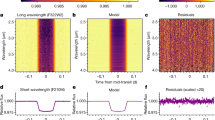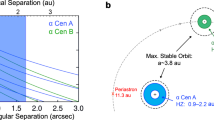Abstract
Three exoplanets around the star HR 8799 have recently been discovered by means of differential imaging with large telescopes1. Bright scattered starlight limits high-contrast imaging to large angular offsets, currently of the order of ten diffraction beamwidths, 10λ/D, of the star (where λ is the wavelength and D is the aperture diameter1,2,3,4,5). Imaging faint planets at smaller angles calls for reducing the starlight and associated photon and speckle noise before detection, while efficiently transmitting nearby planet light. To carry out initial demonstrations of reduced-angle high-contrast coronagraphy, we installed a vortex coronagraph6,7,8,9 capable of reaching small angles behind a small, well-corrected telescope subaperture that provides low levels of scattered starlight10,11. Here we report the detection of all three HR 8799 planets with the resultant small-aperture (1.5 m) system, for which only 2λ/D separate the innermost planet from the star, with a final noise level within a factor of two of that given by photon statistics. Similar well-corrected small-angle coronagraphs should thus be able to detect exoplanets located even closer to their host stars with larger ground-based telescopes12,13,14,15, and also allow a reduction in the size of potential space telescopes aimed at the imaging of very faint terrestrial planets.
This is a preview of subscription content, access via your institution
Access options
Subscribe to this journal
Receive 51 print issues and online access
$199.00 per year
only $3.90 per issue
Buy this article
- Purchase on Springer Link
- Instant access to full article PDF
Prices may be subject to local taxes which are calculated during checkout



Similar content being viewed by others
References
Marois, C. et al. Direct imaging of multiple planets orbiting the star HR8799. Science 322, 1348–1352 (2008)
Lafreniere, D., Marois, C., Doyon, R. & Barman, T. HST/NICMOS detection of HR8799b in 1998. Astrophys. J. 694, L148–L152 (2009)
Fukagawa, M. et al. H-band image of a planetary companion around HR 8799 in 2002. Astrophys. J. 696, L1–L5 (2009)
Metchev, S., Marois, C. & Zuckerman, B. Pre-discovery 2007 image of the HR 8799 planetary system. Astrophys. J. 705, L204–L207 (2009)
Biller, B. et al. An imaging survey for extrasolar planets around 45 close, young stars with the simultaneous differential imager at the Very Large Telescope and MMT. Astrophys. J. 173 (Suppl.). 143–165 (2007)
Foo, G., Palacios, D. M. & Swartzlander, G. A. Jr Optical vortex coronagraph. Opt. Lett. 30, 3308–3310 (2005)
Mawet, D., Riaud, P., Absil, O. & Surdej, J. Annular groove phase mask coronagraph. Astrophys. J. 633, 1191–1200 (2005)
Swartzlander, G. A. et al. Astronomical demonstration of an optical vortex coronagraph. Opt. Express 16, 10200–10297 (2008)
Mawet, D. et al. Optical vectorial vortex coronagraphs using liquid crystal polymers: theory, manufacturing and laboratory demonstration. Opt. Express 17, 1902–1918 (2009)
Serabyn, E. et al. Extreme adaptive optics imaging with a clear and well-corrected off-axis telescope subaperture. Astrophys. J. 658, 1386–1391 (2007)
Serabyn, E. et al. Imaging faint brown dwarf companions close to bright stars with a small, well-corrected telescope aperture. Astrophys. J. 696, 40–46 (2009)
Macintosh, B. A. et al. The Gemini Planet Imager: from science to design to construction. Proc. SPIE 7015, 701518 (2008)
Beuzit, J.-L. et al. SPHERE: a planet finder instrument for the VLT. Proc. SPIE 7014, 701418 (2008)
Hodapp, K. W. et al. HiCIAO: the Subaru Telescope’s new high-contrast coronographic imager for adaptive optics. Proc. SPIE 7014, 701419 (2008)
Bouchez, A. H. et al. The PALM-3000 high-order adaptive optics system for Palomar Observatory. Proc. SPIE 7015, 70150Z (2008)
Jenkins, C. Optical vortex coronagraphs on ground-based telesopes. Mon. Not. R. Astron. Soc. 384, 515–524 (2008)
Bikkannavar, S., Ohara, C. & Troy, M. Autonomous phase retrieval control for calibration of the Palomar Adaptive Optics system. Proc. SPIE 7015, 70155K (2008)
Guyon, O., Pluzhnik, E. A., Kuchner, M. J., Collins, B. & Ridgway, S. T. Theoretical limits on extrasolar terrestrial planet detection with coronagraphs. Astrophys. J. 167 (Suppl.). 81–99 (2006)
Mawet, D. et al. The Vector Vortex Coronagraph: laboratory results and first light at Palomar Observatory. Astrophys. J. 709, 53–57 (2010)
Lafrenière, D., Marois, C. & Doyon, R., Nadeau, D. & Artigau, É. A new algorithm for point-spread function subtraction in high-contrast imaging: a demonstration with angular differential imaging. Astrophys. J. 660, 770–780 (2007)
Malbet, F., Yu, J. W. & Shao, M. High-dynamic-range imaging using a deformable mirror for space coronography. Publ. Astron. Soc. Pacif. 107, 386–398 (1995)
Boccaletti, A., Chauvin, G., Baudoz, P. & Beuzit, J.-L. Coronagraphic near-IR photometry of AB Doradus C. Astron. Astrophys. 482, 939–943 (2008)
Mawet, D., Serabyn, E., Stapelfeldt, K. & Crepp, J. Imaging the debris disk of HD 32297 with a phase-mask coronagraph at high Strehl ratio. Astrophys. J. 702, L47–L50 (2009)
Acknowledgements
This work was carried out at the Jet Propulsion Laboratory, California Institute of Technology, under contract with the National Aeronautics and Space Administration, and is based on observations obtained at the Hale Telescope, Palomar Observatory, as part of a continuing collaboration between the California Institute of Technology, NASA/JPL, and Cornell University. We thank the staff of the Palomar Observatory and both the JPL and Caltech Palomar Adaptive Optics (PALAO) teams, as well as our colleagues at JDS Uniphase, where our vortex masks are manufactured.
Author Contributions All authors contributed equally to this work.
Author information
Authors and Affiliations
Corresponding author
Ethics declarations
Competing interests
The authors declare no competing financial interests.
Supplementary information
Supplementary Figures
This file contains Supplementary Figure S1 with legend. (PDF 113 kb)
Rights and permissions
About this article
Cite this article
Serabyn, E., Mawet, D. & Burruss, R. An image of an exoplanet separated by two diffraction beamwidths from a star. Nature 464, 1018–1020 (2010). https://doi.org/10.1038/nature09007
Received:
Accepted:
Issue Date:
DOI: https://doi.org/10.1038/nature09007
This article is cited by
-
Astrophotonics: astronomy and modern optics
The Astronomy and Astrophysics Review (2021)
-
Wavelength-adaptable effective q-plates with passively tunable retardance
Scientific Reports (2019)
-
Twisting of light around rotating black holes
Nature Physics (2011)
Comments
By submitting a comment you agree to abide by our Terms and Community Guidelines. If you find something abusive or that does not comply with our terms or guidelines please flag it as inappropriate.



